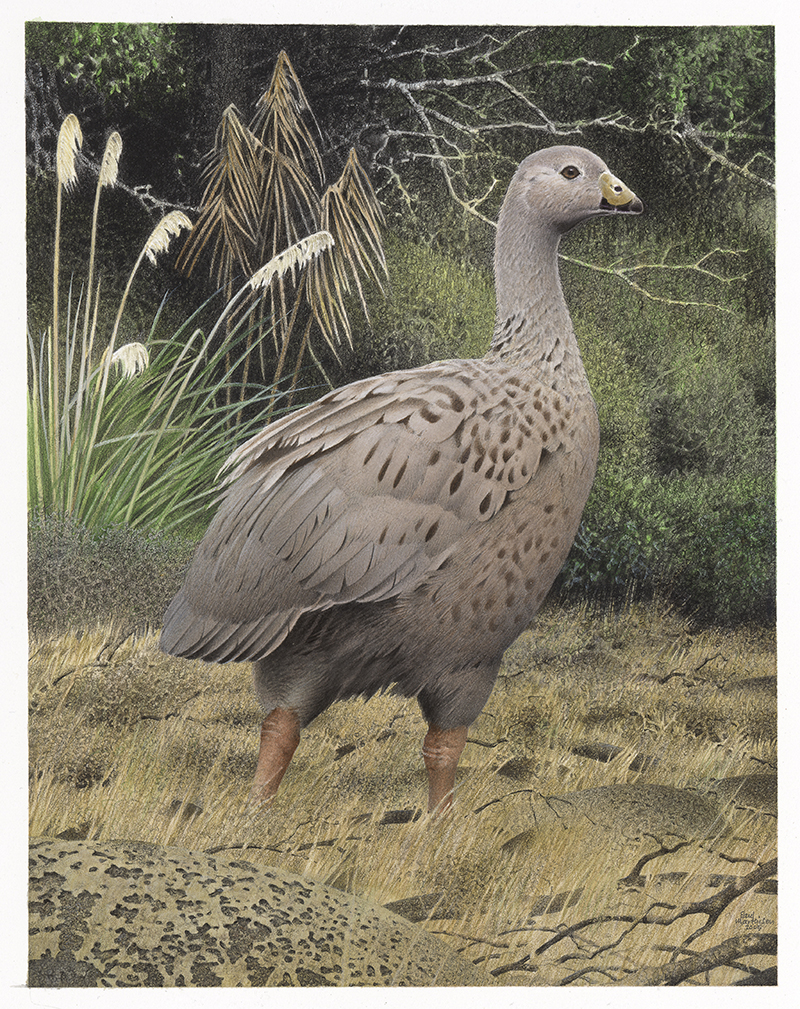Cnemiornis gracilis Forbes, 1892:187
North Island goose
Taxonomy & Nomenclature
Synonym/s: Cnemiornis gracilis Forbes, 1892: Trans. N.Z. Inst. 24: 187 – Te Aute, Hawke’s Bay.; Cnemiornis septentrionalis Oliver, 1955: New Zealand Birds, 2nd edition: 602 – Hunterville, Rangitikei.; Cnemiornis gracilis Forbes; Checklist Committee 1990, Checklist Birds N.Z.: 100.
C. minor is also used to refer to this species according to (Fuller, 1988:46), although it is considered a junior synonym of C. calcitrans by (Hume & Walters, 2012:43; Checklist Committee (OSNZ), 2022:27).
Conservation Status
Extinct
Distribution
North Island, New Zealand
Biology & Ecology
Hypodigm
Media

Above: North Island Goose. Cnemiornis gracilis. From the series: Extinct Birds of New Zealand., 2005, Masterton, by Paul Martinson. Purchased 2006. © Te Papa. CC BY-NC-ND 4.0. Te Papa (2006-0010-1/28)
References
Original scientific description:
Forbes, H. O. (1892). Preliminary notice of additions to the extinct avifauna of New Zealand. Transactions and Proceedings of the New Zealand Institute 24: 185-189.
Other references:
Checklist Committee (OSNZ). (2010). Checklist of the Birds of New Zealand, Norfolk and Macquarie Islands, and the Ross Dependency, Antarctica (4th ed.). Ornithological Society of New Zealand & Te Papa Press, Wellington. [p. 34-35]
Checklist Committee (OSNZ). (2022). Checklist of the Birds of New Zealand (5th edition). Ornithological Society of New Zealand Occasional Publication No. 1. Wellington: Ornithological Society of New Zealand. [p. 27]
Davidson, J. (1978). Archaeological salvage excavations at Paremata, Wellington, New Zealand. National Museum of New Zealand Records 1: 203-236.
Dawson, E. W. (1958). Re-discoveries of the New Zealand subfossil birds named by H. O. Forbes. Ibis 100: 232-237. [Summary]
Drew, S.H. 1897. Natural history notes. Transactions and Proceedings of the New Zealand Institute 29: 284–287.
Fleming, C.A. 1953. The geology of Wanganui Subdivision. New Zealand Department of Scientific and Industrial Research Bulletin (new series) 52: 1–362.
Fuller, Errol. (1988). Extinct Birds. New York: Facts on File Publications. 256 pp.
Gill, B. J., Grant-Mackie, J. A. and Hayes, B. (2005). A Middle Pleistocene goose bone (Anserinae: Cnemiornis) from Hawke's Bay, New Zealand. Records of the Auckland Museum 42: 75-79.
Gill, Brian and Martinson, Paul. (1991). New Zealand's extinct birds. New Zealand: Random Century.
Holdaway, Richard N., Worthy, Trevor H. and Tennyson, Alan J. D. (2001). A working list of breeding bird species of the New Zealand region at first human contact. New Zealand Journal of Zoology 28: 119-187.
Hume, Julian Pender and Walters, Michael. (2012). Extinct Birds. London: T & AD Poyser. 544 pp.
Medway, David G. (1971). Sub-fossil avian remains from the Awakino - Mahoenui area. Notornis 18(3): 218-219.
Oliver, W. R. B. (1955). New Zealand birds. Second edition. Wellington: A.H. & A.W. Reed. 661 pp.
Hugh Robertson, John Dowding, Graeme Elliott, Rod Hitchmough, Colin Miskelly, Colin O’Donnell, Ralph Powlesland, Paul Sagar, Paul Scofield, Graeme Taylor. (2013). Conservation status of New Zealand birds, 2012. New Zealand Threat Classification Series 4. 22 pp.
Rothschild, Lionel Walter. (1907). Extinct birds: an attempt to write in one volume a short account of those birds which have become extinct in historical times, that is within the last six or seven hundred years: to which are added a few which still exist, but are on the verge of extinction. London: Hutchinson & Co. XXIX + 243 pp. [p. 98]
Sayol, Ferran, Steinbauer, Manuel J., Blackburn, Tim M., Antonelli, Alexandre and Faurby, Søren. (2020). Anthropogenic extinctions conceal widespread evolution of flightlessness in birds. Science Advances 6(49): eabb6095. https://doi.org/10.1126/sciadv.abb6095 [Supplementary Material (Data File S1)]
Tennyson AJD and Martinson P (2006) Extinct Birds of New Zealand. Te Papa Press, Wellington.
Tyrberg, Tommy. (2009). Holocene avian extinctions, pp. 63-106. In: Turvey, Samuel T. (ed.). Holocene Extinctions. Oxford, UK & New York, USA: Oxford University Press. xii + 352 pp.
Watanabe, Junya. (2017). Quantitative discrimination of flightlessness in fossil Anatidae from skeletal proportions. The Auk 134(3): 672-695.
Williams, G. R. (1962). Extinction and the land and freshwater-inhabiting birds of New Zealand. Notornis 10(1): 15-32.
Worthy, Trevor H. (2000). Two late-Glacial avifaunas from eastern North Island - Te Aute and Wheturau Quarry. Journal of the Royal Society of New Zealand 30(1): 1-26.
Worthy, T.H.; Edwards, A.R. & Millener, P.R. 1991. The fossil record of moas (Aves: Dinornithiformes) older than the Otira (last) glaciation. Journal of the Royal Society of New Zealand 21: 101–118.
Worthy, Trevor H. and Holdaway, Richard N. (2000). Terrestrial fossil vertebrate faunas from inland Hawke's Bay, North Island, New Zealand. Part 1. Records of the Canterbury Museum 14: 89-154.
Worthy, Trevor H. and Holdaway, Richard N. (2002). The Lost World of the Moa. Bloomington: Indiana University Press.
Worthy, Trevor H.; Holdaway, R. N.; Sorenson, M. D., and Cooper, A. C. (1997). Description of the first complete skeleton of the extinct New Zealand goose Cnemiornis culcitruns (Aves: Anatidae), and a reassessment of the relationships of Cnemiornis. J. Zool., Lond. 243: 695-723.
Worthy, Trevor H. and Swabey, S. E. J. (2002). Avifaunal changes revealed in Quaternary deposits near Waitomo Caves, North Island, New Zealand. Journal of the Royal Society of New Zealand 32: 293-325.
Young, H. Glyn, Tonge, Simon J. and Hume, Julian Pender. (1996). Review of Holocene wildfowl extinctions. Wildfowl 47: 167-181.
